Here’s Why You Should Invest in a Good Countertop RO System
The most effective way to minimize and eliminate numerous harmful chemicals from drinking water, including lead, arsenic, and chromium, is using reverse osmosis (RO). However, whole-house RO systems are not exactly inexpensive, and not all of your taps really need to be supplying purified water.
Countertop units don’t need installation or piping because they have fewer filtration steps than the majority of under sink RO systems. No drain line connection, no drilling through your countertop or sink to make room for the additional dispenser.
Countertop RO systems can be used independently or quickly connected to any common faucet. They are therefore ideal for rental properties where tenants are prohibited from altering the plumbing as well as for anyone who simply doesn’t want to fiddle with under-the-sink connections.
Additionally, a lot of water filtration systems are small and portable, making them perfect for people with small homes, students, and travelers who are often on the go and need a countertop water filter system they can carry with them.
Because of this, countertop RO systems become the logical option for people who just wish to have clean drinking water at a reasonable price. Of course, shopping for anything on the open market in this era of overabundance might be bewildering, so we done the legwork and compiled a list of the top countertop RO units for you.
Best Countertop Reverse Osmosis System Reviews
AquaTru
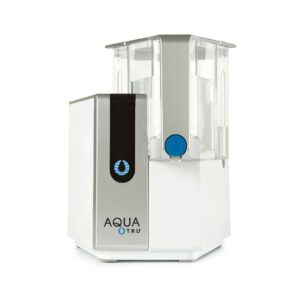
Specifications:
- Efficiency Ratio: 4:1
- Filtration: 4 filter stages
- Production Rate: ~1 GPM
- Holding Capacity: 1 gallon, 3 quarts
- Certifications or Testing: NSF 42, 53, 58, 401, P473
- Annual Cost: ~$120
One of those uncommon countertop reverse osmosis (RO) systems, the AquaTru Countertop Reverse Osmosis Water System comes with a performance data sheet that states exactly which contaminants it can remove and with what degree of success.
It is one of the few RO systems to have all the key NSF certifications. It is our top choice since the 82 contaminants listed in that page show a great filtration ability for harmful toxins like lead, copper, barium, radium, and chromium.
The AquaTru RO System’s cutting-edge 4-stage filtration method, which it uses, makes it effective at removing certain contaminants:
1. Mechanical pre-filter: It stops big objects like silt from getting into the reverse osmosis system and impeding the filtration procedure.
2. Activated carbon filter: It lessens the majority of aesthetically bothersome pollutants like chlorine and chloramines, enhances turbidity, and reduces the amount of chemicals and heavy metals in the water, which helps the RO membrane do its job more effectively.
3. RO membrane: The data sheet’s claimed removal rates are made possible by this RO membrane’s high efficiency.
4. Volatile organic compound (VOC) filter made of activated coconut shell carbon: This filter is intended to capture VOCs that may have gotten past the RO membrane.
This countertop reverse osmosis system features two tanks in addition to these four filters: a 3-gallon tank for tap water and a 1-gallon tank for filtered water. Within minutes of plugging in the appliance and filling the tank with tap water, you can begin receiving filtered water.
Even better, the filtered water tank can be completely removed from the device. You can just store it in your refrigerator and have filtered cold water whenever you want on hot summer days.
However, compared to the other products on our list, the filters of this particular gadget don’t last as long. Depending on how you use the device, the LED display will likely let you know that it’s time to replace the filters in 4 to 6 months.
Last but not least, it is the least environmentally friendly option on our list due to its wastewater ratio of one cup down the drain for every pure cup of water. The fact that this product requires frequent filter replacement and has water-wasting features will ultimately drive up your costs is another drawback given how pricey it currently is.
Pros
- We appreciate that the AquaTru has been proven to decrease or eliminate 82 pollutants according to NSF Standards. This ensures that the countertop reverse osmosis system will give your home the best-tasting, purest, cleanest, and safest drinking water possible. Note that thousands more pollutants are really removed by the system; these 82 are just the ones that are tested for.
- This approach not only saves space, but it’s also quite simple to use, so you won’t have to spend time figuring out how to use it when you first set it up. Simply press a button to discharge water, and periodically empty the waste tank.
- You should anticipate spending about $100 a year on filter changes for maintenance, which isn’t too awful. The RO membrane lasts for two years, whereas the filters last for about six to twelve months (600 gallons) (1,200 gallons).
- In terms of effectiveness, this countertop water filtration system is far less wasteful than other systems because it only wastes 20% to 30% of the water it uses and produces 70% to 80% pure water.
Cons
- Some clients reported leaky issues and broken equipment.
- Unit not certified by the NSF itself.
RKIN AlcaPure
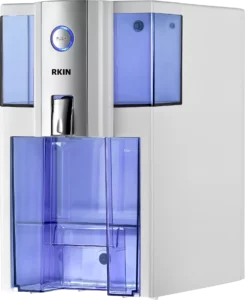
Specifications:
- Efficiency Ratio: 3:1
- Filtration: 4 filter stages
- Production Rate: 45.4 GPD
- Holding Capacity: 0.50 gallon
- Certifications or Testing: NSF 58
- Annual Cost: ~$70
The greatest countertop RO filter with alkaline filtration available right now is the RKIN Zero Installation system. We adore this water filtration system for its ability to completely remove more than 1000 impurities, including lead, fluoride, mercury, heavy metals, arsenic, and chlorine. Of course, we also like it for its remineralization step, which replenishes the water with beneficial minerals.
Remineralization option – The AlcaPure and RKIN OnliPure choices are what really set this RKN filter different.
Alkaline remineralization is a stage in the AlcaPure option. This gives your cleaned water an alkaline flavor that is more pleasant and reminiscent of bottled water by reintroducing a little amount of 78 trace minerals to it (pH 7 or 8).
Alternatively, if you don’t care about remineralization, you can choose the RKIN OnliPure Edition Filtered Water system, which is perfect for anyone looking for the purest water possible because it doesn’t add any TDS (total dissolved solids) to water in the form of minerals.
The RKIN purifier filters water using a four-stage countertop reverse osmosis water filtration system that includes a reverse osmosis membrane, an activated carbon pre-filter for particulates, and an activated carbon VOC filter. The Quintessential 3.3 is a remineralization filter as well. Although you’ll need to hook this device into an electrical source, it won’t use that much power (about 30W).
Pros
- RKIN AlcaPure filters and remineralizes water to give you the best of both worlds. This countertop reverse osmosis water system provides the certainty of pollutant removal as well as the health advantages and delicious alkaline minerals.
- AlcaPure uses a ratio of 1:1, which means that for every gallon of water wasted, 1 gallon of pure water is generated (or 50% of the water is wasted). In comparison to many under-sink RO filtering systems, this is significantly more effective, however it still falls short of AquaTru’s 20%–30% water waste.
- In this price range, you won’t find a more effective RO and remineralization filter. Given the efficiency of its filtration and remineralization procedures, the unit’s price of just under $500 is a great deal.
Cons
- The AquaTru, which is our top pick, is more effective than this appliance. Water waste will increase.
- There is a price for remineralization. You might not be able to rationalize spending $100 more than our top option for a few extra minerals, even though we believe the AlcaPure filter to be an excellent value for the money.
Waterdrop WD-N1-W
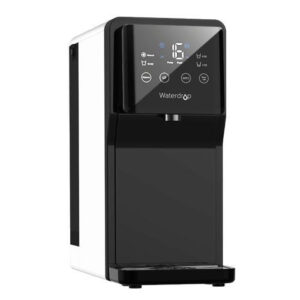
Specifications:
- Efficiency Ratio: 3:1
- Filtration: 2 filter stages
- Production Rate: 75 GPD
- Holding Capacity: 0.39 gallon
- Certifications or Testing: NSF 58, 372
- Annual Cost: ~$70
The Waterdrop WD1 is smaller, more portable, and more reasonably priced while retaining all the essential characteristics of its sibling, the K19 model. We adore how simple it is to carry!
It uses a 4-stage filtration method, similar to the K19, consisting of PP cotton, carbon blocks, RO membranes, and UV light. The Waterdrop WD1 differs in that this procedure occurs in two cartridges rather than just one.
One of these two cartridges, which must be changed once every six months, contains the polypropylene sediment filter and carbon block. 18 months is the average lifespan of the RO membrane.
Despite using a different approach, the Waterdrop WD1 is just as effective as the K19 in removing pollutants. It greatly reduces the levels of heavy metals, TDS, chlorine, nitrates, and cosmetic imperfections, providing you and your family with hygienic, spotless, and delicious water.
The wastewater ratio (3:1), water dispensing settings, and LED display are all identical to those of its sibling model. One distinction is that it only has a 0.8 gallon water tank, making it a more practical choice for single individuals or couples without children.
Nevertheless, it ultimately has the same fundamental drawbacks as the Waterdrop K19: it is not NSF-certified and is not suitable for use with well water.
Pros
- There aren’t many RO filters that have an integrated UV purifier. You get the assurance of pathogen-free, drinkable water with this Waterdrop unit.
- One of today’s least wasteful systems, the WD-N1-W only wastes 1 gallon of water for every 3 gallons of pure water generated. Although it’s not quite the 4:1 ratio of the AquaTru, it’s close.
- Simple maintenance. While you must also clean the water tank in addition to the system, it will auto-flush to clean itself. There are only two filters that need to be changed: the MRO filter can last up to 18 months and the CF (carbon) filter lasts for 6 months.
Cons
- Even though the Waterdrop removes up to 90% TDS, it doesn’t provide the most comprehensive countertop RO solution.
- We’ve seen consumer reports about the unit leaking or dribbling.
NU Aqua 4-Stage Countertop Reverse Osmosis System
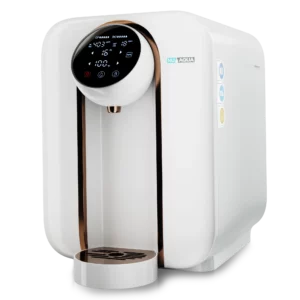
Specifications:
- Efficiency Ratio: 5:1
- Filtration: 4 stages
- Production Rate: 75 GPD
- Holding Capacity: 1 gallon
- Certifications or Testing: NSF 58
- Annual Cost: ~$150
All of the systems we have so far studied and will review below have a maximum water temperature of 77 degrees Fahrenheit. However, the Nu Aqua RO System features a built-in fast water heating system that enables it to function effectively even with water temperatures greater than 77F. Regardless of whether the system is countertop or not, that is a fantastic feature.
Additionally, the Nu Aqua allows you to modify the water heater’s temperature to suit your preferences. It functions similarly to the Waterdrop versions in that it filters tap water as it travels from its 1-gallon tank to its spigot and offers the 4 oz, 8 oz, 16 oz, and 32 oz options for on-demand water dispensing.
It contains two distinct filter cartridges that must be changed every six months, just like the Waterdrop WD1. The first of them has a sediment filter to stop large particles from entering the system and a carbon block filter to get rid of giardia-causing bacteria, chlorine, and other noxious substances.
A highly regarded reverse osmosis membrane, found in the second cartridge, may effectively remove pollutants, heavy metals, and TDS. The water then goes through a granular activated carbon filter to get rid of any leftover particles from the other water filtration system processes.
The 5:1 wastewater ratio is all the more amazing when you consider how effective its RO membrane is. It is the most environmentally friendly item on our list in that regard.
Additionally, unlike the other models we’re recommending, it has the ability to treat well water, so its advantages don’t end there. There is one requirement: the water’s initial TDS levels must be under 500 ppm (parts per million).
Naturally, the Nu Aqua RO System is one of the priciest products on our list, so all these advantages come at a cost. Given that both filter cartridges must be replaced every six months, it may easily end up being a pricey item.
Pros
- Overall, the NU Aqua 4-Stage Countertop Reverse Osmosis System is a great system. There are more reasons to adore this item in addition to the hot water delivery option, which is undoubtedly a selling element. Other reasons to proudly display this unit in your kitchen are its 75 GPD water production rate, four complete filtration stages, testing to NSF Standard 58, and appealing, contemporary appearance.
- This system is simple to install and configure. We believe you’ll enjoy it if you put convenience before almost anything else.
- One of the most effective units we’ve ever tested is this one. It has a 5:1 efficiency rating, which implies that for every 5 gallons that are produced, just 1 gallon of water is wasted. Even better is the 4:1 efficiency rating of our top pick, the AquaTru system.
Cons
- Given the NU Aqua system’s hot water feature, the $450 price tag is very reasonable, yet some individuals may find it to be too expensive.
Crystal Quest Portable Reverse Osmosis System
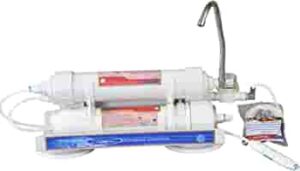
Specifications:
- Efficiency Ratio: –
- Filtration: 10 stages
- Production Rate: 50 GPD
- Holding Capacity: 0.30 gallon
- Certifications or Testing: –
- Annual Cost: ~$100
The greatest countertop reverse osmosis system on a budget, in our opinion, is the Crystal Quest Portable Reverse Osmosis System. This faucet-using system costs less than $200, which is less than half the cost of the AquaTru, which is our top choice on this list. If you spend less, don’t think that you have to sacrifice quality because this system features a sizable 10 stages of filtration and a good 50 GPD delivery rate.
With 10 filtering stages, the Crystal Quest RO system eliminates a wide spectrum of pollutants. Chlorine, VOCs, and pesticides are removed by the granular activated carbon filter; the majority of the TDS is removed by the countertop reverse osmosis membrane; lead, chromium, and arsenic are removed by the copper-zinc oxidation media, which also inhibits the growth of bacteria; the hard water minerals are removed by the ion exchange resin; and the remaining tastes and odors are removed by the GAC post-filter.
This Crystal Quest device is more portable than the other selections on this list thanks to a number of convenient features. The unit’s advantage is that it doesn’t require energy, allowing you to transport it anywhere that has a typical US faucet. About 2 gallons per hour, or 50 GPD, is the filter flow rate. Although it’s just half as quick as the AquaTru model, 50 GPD is sufficient for most households.
Pros
- The annual operating and maintenance costs for this high-performance system range from $70-$90.
- Don’t be deceived by the somewhat awkward design of this filter system. It comes with everything you need for the job and is promptly set up. Additionally, it’s lightweight and small, making it simple to transport without taking up too much room.
- It’s impressive that you get a whole 10 stages of filtration for less than $200.
Cons
- The Crystal Quest produces about 2 gallons of filtered water per hour, which is slightly less than other countertop water filter system models on the market, including our top choices on this list.
- The holding capacity of 0.30 gallons is the lowest of any filter on this list.
Countertop RO System Buyer’s Guide
What is a Countertop Reverse Osmosis System?
Countertop reverse osmosis systems are designed to be stored on a kitchen countertop and integrate the several phases of reverse osmosis into one small system. These systems provide clean, pure water with enhanced taste and odor by removing up to 99% of total dissolved solids (TDS). This enables a more comprehensive filtration than is possible with conventional technologies.
Countertop reverse osmosis systems are gaining popularity despite the fact that most RO systems are built for installation underneath a kitchen sink.
This kind of portable water purifier is perfect for renters who still want to benefit from filtered water and don’t want to deal with the trouble of having to cut through their waterline to install a reverse osmosis filter.
How Does A Countertop RO System Work?
Water for RO countertop water filters either comes directly from the tap or is stored in a tank that needs to be topped off and refilled. When water is added to this system, it goes through several stages of filtration before emerging as clean water from the spout.
The following are the general filtration stages:
1. Sediment pre-filter. Any water filtration system must include this stage, which clears the water of particles like sand, dust, and rust.
2. A granular or activated carbon filter. Adsorption is used in this to remove pollutants, chlorine, and undesirable tastes and odors from water.
3. Reverse osmosis membrane. This technology can filter out up to 99.9% of all dissolved solids.
4. An additional carbon filter. This gets rid of leftover sediment.
5. A few versions of countertop reverse osmosis water filtering systems also include an alkaline remineralization filter, which adds beneficial minerals back into the purified water. anyone who wishes to benefit from filtered water while renting a home.
Advantages
- One of the most tried-and-true processes for creating clean water is reverse osmosis. It is so efficient that it virtually eliminates all contaminants from tap water.
- A countertop water filter often has very good filtration speed.
A countertop water filter is simple to set up; it just requires a few minutes to place it on your counter. There is little chance that you will make a mistake, and you won’t need to hire a plumber. - Renters can install countertop reverse osmosis water filtration system models because they don’t need an intrusive under-sink installation.
- Compared to an under-sink filtered water system, maintaining a countertop reverse osmosis water filter is significantly simpler and less expensive.
- Reverse osmosis countertop water filtration systems are typically portable due to their small size. You can carry them with you for great-tasting water on the go because they only need a water supply connection or access to water to be filled.
- Contrary to countertop water filters, most under-sink reverse osmosis water filter systems incorporate a water storage tank
Disadvantages
- Any countertop reverse osmosis system that requires connection to a faucet will only work with a kitchen faucet, regardless of the model.
- Countertop reverse osmosis creates clean, high-quality drinking water, but some people complain that the drinking water has a bland flavor since RO removes it of all its minerals.
- In the RO process, water is lost in all countertop RO water filtration devices. Due to the process involved in creating reverse osmosis water, this is something that cannot be avoided.
Considerations When Buying The Top Countertop RO Filters
Water Source
It is important to think about your water source while choosing a countertop reverse osmosis system.
Reverse osmosis removes the vast majority of impurities from water, but even the greatest countertop water filtration systems may not be able to catch all of them. These impurities include hydrogen sulfide, some pesticides, some herbicides, and some VOCs.
Contaminants Removed
When buying a RO system, the next thing to consider is whether it removes toxins like lead, which cause issues in many American homes. Since RO is the most effective filtration technique for treating lead, you can be sure that every item on our list can handle it.
The equipment is typically evaluated by a third-party lab in order to establish scientifically how many contaminants a RO system eliminates. However, not all manufacturers take the time to test their products and give customers a precise figure.
Water Pressure
If you’re utilizing a countertop reverse osmosis system that is connected to your kitchen faucet, your water pressure is also crucial. Limiting water waste requires a water flow that is strong enough to quickly travel through the reverse osmosis membrane.
Your water pressure is unimportant if you’re utilizing a countertop reverse osmosis system that plugs into a power source. The water will go through the system at the necessary speed thanks to the electricity.
Flow Rate
Water pressure in your house has an impact on flow rate. The flow rate increases with increasing water pressure.
Once more, if you’re utilizing a countertop reverse osmosis water filtration system that attaches to your faucet, you simply need to be concerned about flow rate.
Faster access to clean drinking water is made possible by your system’s ability to move things forward swiftly. Due to insufficient water flow across the RO membrane at a sluggish flow rate, additional effluent will be generated.
Storage Volume
If you’re looking to get a reverse osmosis filter that isn’t connected to a faucet, storage capacity is something to take into account.
A tap water storage tank is a feature of a stand-alone countertop RO system. It will be your responsibility to refill the water after it has been completely consumed. Therefore, it should go without saying that you’ll want the most storage space feasible to minimize your work.
Set a storage capacity of at least 1 gallon as your standard since this is what the majority of RO filter systems have.
Filter Lifespan
Prior to purchasing a RO system, you should constantly be informed of the water filter’s lifespan.
Short-lived reverse osmosis filters will result in a longer-term increase in system cost. For the reverse osmosis filter membrane, look for one with a minimum lifespan of 2 years and a 6-month sediment filter and post-filter. For a countertop water filtering system, this is rather typical.
Available Space
You must have the space available for a reverse osmosis countertop system, regardless of the model you choose. Consider countertop reverse osmosis water filtering systems with a smaller footprint that don’t take up as much space width-ways if your countertop space is somewhat limited.
Measure the area you have available and compare it to the specifications of any reverse osmosis filters you are thinking about purchasing to avoid purchasing a system that is too large.
Wastewater Ratio
Yes, the RO process eliminates or removes a lot of pollutants, but it also generates a lot of wastewater in the process. For just one cup of potable water, some full home countertop reverse osmosis systems may even drain five cups of effluent.
Because their membranes are less efficient and lack a drain hose, countertop reverse osmosis systems are far less wasteful than whole-house reverse osmosis units. Yet, we have observed instances where individuals waste 4 cups to offer just 1 cup that has been cleansed.
Therefore, it is essential to choose a system with a low wastewater ratio in order to be as environmentally friendly as possible and to avoid paying excessive water bills.
Maintenance Requirements
Semipermeable RO membranes often need to be replaced once a year, however this ultimately relies on the manufacturer’s recommendations and how frequently you use the device. Fortunately, all of the appliances on our list—with the exception of PuroSmart—have LED displays that will alert you when it’s time to change the countertop reverse osmosis water filters.
The RO membrane is not the only filter that needs to be changed, though. For the majority of the devices on our list to continue effectively filtering your water, you should change the carbon filters and pre-filters around every six months.
NSF Certification
A nonprofit organization called the National Sanitation Foundation (NSF) studies and assesses the health effects of goods in a range of markets, from water treatment systems to automotive parts. Customers are reassured by NSF certifications that a manufacturer’s health claims about their product are validated by research.
Even though they can encourage customer trust, the majority of producers of reverse osmosis systems ignore the significance of these certifications. Again, the AquaTru Countertop RO System is the only item with the necessary certifications.
According to the National Secondary Drinking Water Regulations of the EPA, NSF/ANSI 42 certifies that the device is capable of removing aesthetic pollutants that affect the taste, color, and odor of water.
- NSF/ANSI 53: In accordance with the National Primary Drinking Water Regulations (NPDWRs) established by the EPA in the case of the United States and Health Canada in the case of Canada, NSF/ANSI 53 certifies that the device can decrease pollutants that have a negative impact on health.
- NSF/ANSI 58: This standard solely applies to reverse osmosis systems, and it confirms that the device effectively forces water through a semipermeable membrane.
- NSF/ANSI 401: This standard attests to the product’s ability to eliminate at least 15 of the developing pollutants. Emerging contaminants, also known as contaminants of emerging concern, are substances that are neither aesthetic impurities nor currently subject to EPA regulation under NPDWRs.
Warranty
A strong warranty is always a major bonus for pricey electronics-based products like LED displays.
We should point out that the majority of these gadgets are only capable of handling the water conditions listed in the instruction manuals, and should you violate those guidelines, the manufacturer may void your warranty. Therefore, before using, carefully read the warranty’s fine print as well as the instruction manual.
Price
One of the most expensive water purification methods available is the reverse osmosis system. Countertop RO systems cost $300 to $500, which is still more expensive than non-reverse osmosis systems, despite being somewhat more reasonable than whole-house RO systems.
Frequently Asked Questions
Can countertop reverse osmosis filtration systems remove the same contaminants as under-sink reverse osmosis filters?
Yes – countertop RO systems and under-sink reverse osmosis systems can remove the same contaminants. The only difference between countertop RO systems and under-sink RO systems is their size. Lead, chlorine, germs, and heavy metals are among the contaminants that counter RO filters can remove.
Additionally, RO systems are able to remove fluoride and even viruses from drinking water, giving it a quality similar to bottled water.
Which countertop RO system gets rid of the most impurities?
The most effective countertop RO system available is the AquaTru RO System. The fact that it can remove certain toxins is well-established by independent test results and NSF certifications, and it does so with a remarkable success rate of 82 contaminants.
What water pressure should I have at home to install a countertop reverse osmosis water filtration system that connects to my faucet?
A pressure of between 40 and 100 psi is often suitable for ensuring that these reverse osmosis systems can function at their best. But even low pressure flowing from your faucet isn’t the end of the world because the majority of these systems have a pressure booster.
Which filter—one that attaches to a faucet or one that has a dispenser-style counter top—is preferable?
Both systems are simple to use and ideal for apartments, so the choice really comes down to your tastes. Dispenser-style reverse osmosis water filters are clearly the superior option if you intend to bring yours to work because they are more transportable.
How long does a countertop RO system typically last?
Whether installed on a countertop or not, reverse osmosis systems typically last 10 to 15 years. However, that ultimately depends on how well you care for the appliance and whether you’re following the water requirements outlined in the instructions.
The device won’t survive long, and the warranty is probably not going to cover any problems, if you use water that is hotter, has more water pressure, or has greater Total Dissolved Solids levels than it can handle. Therefore, before making a purchase, it’s crucial to ask the vendor or the manufacturer about the water requirements that the equipment can handle.
